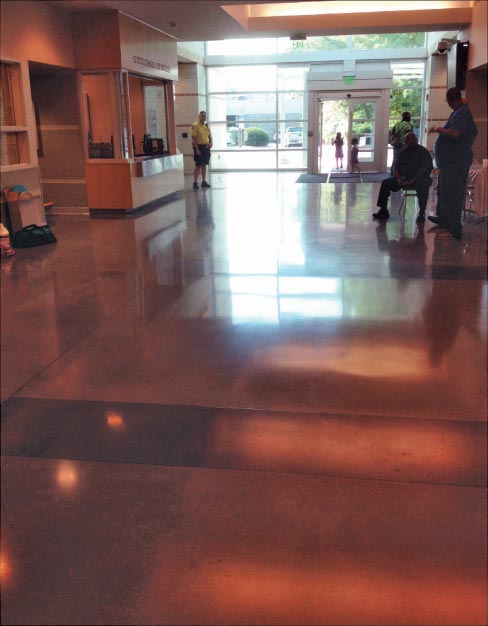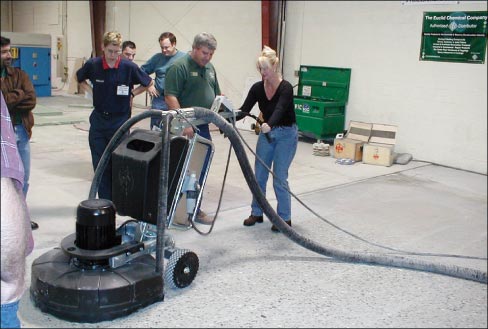Stone Restoration Corner: Polishing Concrete
Bob Murrell
Special Contributor
Photos provided by Bob Murrell
Mouse over photos for captions
 Back in the late 1990s, I was one of the original concrete polishers here in the USA. I typically treated concrete like marble back then. I was involved with one of (if not the first) polished concrete projects for a commercial job in the US. that I am aware of. It was the inventory warehouse in the back of the Bellagio in Las Vegas, NV.
Back in the late 1990s, I was one of the original concrete polishers here in the USA. I typically treated concrete like marble back then. I was involved with one of (if not the first) polished concrete projects for a commercial job in the US. that I am aware of. It was the inventory warehouse in the back of the Bellagio in Las Vegas, NV.
 Of course this was before the days of dry polishing. There were no large planetary machines, densifiers, stains, and guard products. If I remember correctly, we used Cimex machines wet and then polished using marble polishing compound. This combination produced a great look but nothing compared to today’s polished concrete finishes.
Of course this was before the days of dry polishing. There were no large planetary machines, densifiers, stains, and guard products. If I remember correctly, we used Cimex machines wet and then polished using marble polishing compound. This combination produced a great look but nothing compared to today’s polished concrete finishes.
 Now I don’t profess to know all of the latest and greatest methods for polishing concrete. However, I have done my share through the years. I have sold and demonstrated just about all of the major brands of equipment and diamonds.
Now I don’t profess to know all of the latest and greatest methods for polishing concrete. However, I have done my share through the years. I have sold and demonstrated just about all of the major brands of equipment and diamonds.
I do know that many contractors now use both wet and dry methods in combination. When cutting wet, stock is generally removed faster. When cutting dry, a higher degree of finish is achieved. So many concrete polishers will cut wet initially and then switch to a dry operation to achieve the final polish. Each has advantages and disadvantages. It all depends on the existing condition of the concrete and what the expected results are.
Cutting wet with metal bond diamonds will definitely expose the salt and pepper (small surface aggregate) of newly installed slabs. Aggressive wet cutting (less than 70g metal) or use of shot blasters or shavers will expose the large aggregate creating what I call, “poor man’s terrazzo”. This is a unique look and can be quite a lot of work to get to this point, even with the right equipment.
Less aggressive cutting is required to only polish the cream (surface cement) without exposure or minimizing exposure of the fine aggregate. It is just about impossible to not expose any salt and pepper aggregate.
Cutting wet will cut faster but generates a lot of slurry which must be properly disposed of. There are commercial products that will solidify the slurry waste so that it will harden and can be disposed of in conventional methods to a land fill. Cutting dry requires a commercial dust extractor system. Of course the bags of collected dust can be easily disposed of in the land fill.
Using densifiers to harden the surface for a better and easier polish is fairly routine today. Densifiers are typically applied after a 200 grit or 400 grit resin puck used dry.
The process is then continued dry to an 800g, 1500g or even a 3000g resin finish. Mostly lithium and potassium densifiers are used today but some also use the sodium type as well. You can do your own research into the chemistry here as I will defer to the manufacturers. I will tell you that for me, the lithium and potassium type are faster and easier to apply. I call them spray and goes.
Some use the densifiers to achieve a shiny look by diluting with water and using as a spray buff type product with a slow speed buffer and a hog hair pad. This will produce a nice gloss after a 400g finish or higher but it won’t last as long as a true mechanical polish.
Most concretes today are fairly hard (at least 2900-4600 psi of compressive strength). Of course harder concretes are available for special applications and at a higher cost. Therefore, when grinding and polishing concrete, the harder the concrete, the softer the bond the diamond abrasive needs to have.
Hard concrete needs soft bond diamonds to cut effectively and soft concrete needs a harder bond diamond to last. Normally a medium to soft bond diamond is sufficient for most contractors.
Diamond impregnated pads are also very popular with getting a nice look on concrete as well as being used for the routine maintenance. They can be used wet or dry, slow speed or high speed. Just like most all diamonds, they cut more slow speed and wet and produce a higher finish high speed and dry.
Contractors will hone to their agreed upon last diamond puck (a 1500g is fairly common) and then use a 1500g and maybe a 3000g diamond impregnated pad under a propane or electric burnisher to get rid of any resin marks and achieve a consistent look.
These pads are also available in very high grit (3000g, 6000g, and 12,000g) series for use under auto-scrubbers in combination with a quality concrete cleaner and conditioner for polished concrete maintenance.
There are colored concretes, dyed concretes, and stained concretes that are related to the heading of polished. Most of the acid stained and dyed concretes will require a surface coating to lock them in. These coatings are called “concrete guard” products. These are also useful when protecting the polished concrete from acidic etching spills (think pickle jar spill in aisle 3) such as in grocery store applications.
There are many issues to consider when polishing, staining and polishing, or even doing surface prep (coatings removal and recoating) concrete projects. I have merely touched on some of the many common current practices. Please always remember to submit a test area to confirm procedures, equipment, and results. And remember: partnering with a reputable distributor of equipment, products and technical support is the most important thing.